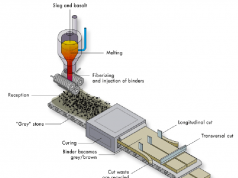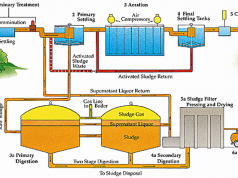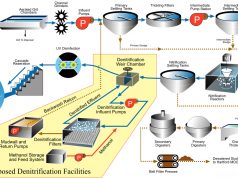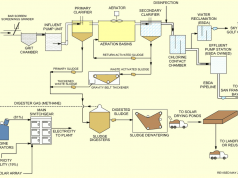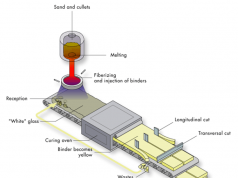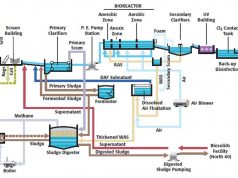Lesson 7: GLOBAL POSITIONING SYSTEM (GPS)
7.1. INTRODUCTION:
1. Từ mới:
- Artificial: [,ɑ:ti’fi∫əl]: adj: nhân tạo, không tự nhiên
- Simplify: [‘simplifai]: v: làm đơn giản, đơn giản hóa.
- State: [steit]: n: trạng thái, tình trạng.
- Track: [træk]: n: theo dõi
- Velocity: [vi’lɔsəti]: n: vận tốc, tốc độ
- Airborne: [‘eəbɔ:n]: n: trên không.
- Unprecedented: [ʌn’presidentid]: adj: chưa từng có, chưa từng thấy
- Attitude: [‘ætitju:d]: n: vị trí
- Parameter: [pə’ræmitə(r)]: n: tham số
- Configuration: [kən,figju’rei∫n]: n: cấu hình
- Motional carrier: vật thể bay
2. Bài đọc:
Global Positioning System (GPS) technology is a branch science of Space Geodesy. The launch of the 1st artificial satellite on October 4th, 1975 results in a new era of Geodesy. The satellite Geodesy that makes use of the signals transmitted by satellites to survey and describe the Earth came into being in the mid 1960’s.
The GPS system consists of 3 major segments:
– A space segment, NAVSTAR satellites that transmit radio signals (simplified as GPS signals) to navigation and positioning users;
– A control segment, ground-based equipment to monitor operation states of GPS in-orbit satellites and update GPS signals;
– A user segment, GPS receiver that can receive passively, track, convert and survey GPS signals to determine three-dimensional position, velocity, and time for land, sea and airborne users anywhere in the world with unprecedented accuracy, even three-dimensional attitude parameters of a motional carrier.
Figure 7.1 summarizes the configuration and operational bases of above three segments.
3. Dịch:
Công nghệ định vị toàn cầu (GPS) là một nhánh của trắc địa không gian. Vệ tinh nhân tạo đầu tiên được phóng vào 4/10/1975 đã mở ra một kỉ nguyên mới cho trắc địa. Trắc địa vệ tinh truyền các tín hiệu bằng vệ tinh để đo đạc và mô tả Trái đất được đưa vào sử dụng vào giữa những năm 1960.
Hệ thống định vị toàn cầu GPS bao gồm 3 đoạn chính:
– Đoạn không gian, vệ tinh NAVSTAR truyền tín hiệu radio (gọi đơn giản là tín hiệu GPS) để đọa hàng và xác định vị trí của người sử dụng.
– Đoạn điều khiển, các thiết bị đặt trên mặt đất để theo dõi tình trạng hoạt động của các vệ tinh GPS trên quĩ đạo và cập nhật tín hiệu GPS.
– Đoạn sử dụng, các máy thu GPS có thể thu nhận một cách bị động, theo dõi, chuyển đổi và đo đạc tín hiệu GPS để xác định tọa độ 3 chiều, vận tốc và thời gian của các máy thu trên mặt đất dưới biển và trên không ở bất kì đấu trên thế giới với độ chính xác chưa từng có, thậm chí cả các tham số vị trí 3 chiều của các thiết bị vận chuyển.
Hình 7.1 tóm tắt cấu hình và hoạt động cơ bản của 3 đoạn trên.
7.2. THE SYSTEM DESIGN AND IMPLEMENTATION:
7.2.1. The space segment:
1. Từ mới:
- Provide: [prə’vaid]: v: cung cấp, cung ứng
- Civilian: [si’viljən]: n, adj: dân sự, dân thường
- Constellation: [,kɔnstə’lei∫n]: n: chòm sao
- Spare: [speə]: n: dự trữ
- Incline: [in’klain]: n,v: nghiêng, dốc
- Equator: [i’kweitə]: n: xích đạo
- Nominal: [‘nɔminl]: n: danh nghĩa
- Corresponding: [,kɔris’pɔndiη]: adj: tương ứng, ứng với
- Semimajor axis: bán trục lớn
- Period: [‘piəriəd]: n: thời kì, giai đoạn, chu kì
- Pseudo-random: giả ngẫu nhiên
- Predict: [pri’dikt]: v: dự báo
- Ephemeris: [i’feməris]: n: lịch vệ tinh
- Atmospheric: [,ætməs’ferik]: adj: thuộc khí quyển
- Propagation: [,prɔpə’gei∫n]: n: truyền bá
2. Bài đọc:
After launching the first test GPS satellite on February 22th, 1978 the engineering development phase came into operation.
At present, twenty-six operation satellites in orbits can provide the navigation and positioning service for military and civilian users. According to the original plan, the GPS constellation contains 21 operation satellites plus 3 in-orbit spares (fig.7.2)
The operation satellites are arrayed in 6 orbit planes inclined 55 degrees to the equator. Each orbit is circular with the nominal altitude of 20,200km, corresponding to about 26,600km for the semimajor axis. The corresponding orbital period is twelve sidereal hour, one half of the Earth’s period of rotation. Each satellite transmits two frequency signals for navigation and positioning: L1 on 1575.42 MHz and L2 on 1227.60 MHz. The carrier signals are modulated by two pseudo-random noise (PRN) codes and a navigation message that includes a predicted satellites ephemeris, atmospheric propagation correction data, satellite clock error information and satellite health data.
3. Dịch:
Sau khi phóng vệ tinh thử nghiệm đầu tiên vào 22/2/1978, thời kì phát triển của việc ứng dụng kĩ thuật đã chính thức đi vào hoạt động.
Hiện nay, 26 vệ tinh đang hoạt động trên quỹ đạo có thể cung cấp các thông tin đạo hàng và định vị phục vụ cho quân đội và dân sự. Theo kế hoạch ban đầu, vệ tinh GPS bao gồm 21 vệ tinh hoạt động và 3 vệ tinh dự trữ.
Các vệ tinh hoạt động được phân bố trong 6 mặt phẳng quỹ đạo nghiêng 55 độ so với xích đạo. Mỗi quỹ đạo là một vòng tròn có độ cao danh nghĩa là 20,200km, tương ứng là khoảng 26,600km so với bán trục lớn. Chu kì quỹ đạo tương ứng là 12h thiên văn, tương ứng với một nửa chu kì quay của Trái đất. Mỗi vệ tinh truyền 2 tần số sóng phục vụ đạo hàng và định vị: L1 với tần số 1575.42MHz và L2 với tần số 1227.60MHz. Tín hiệu sóng tải được điều biến bởi 2 mã nhiễu giả ngẫu nhiên và một thông tin đạo hàng bao gồm một lịch vệ tinh dự báo, số hiệu chỉnh dữ liệu lan truyền trong khí quyển, thông tin về sai số đồng hồ vệ tinh và tình trạng vệ tinh.
7.2.2. The control segment:
1. Từ mới:
- Consolidate:[kən’sɔlideit]: v: thống nhất
- Behavior: [bi’heivjə]: n: phản ứng, cách hoạt động
- Inject: [in’dʒekt]: v: truyền
- Broadcast: [‘brɔ:dkɑ:st; ‘brɔ:dkæ:st]: n,v: quảng bá
- Gather: [‘gæđə]: n: tập hợp
- Relay: [ri’lei]: v: tiếp âm (một chương trình), truyền
2. Bài đọc:
The control segment includes a master control station (MCS) at the consolidated Space Operation Center at Colorado Spring, and a number of monitor stations, located throughout the world, such as the stations on Diego Garcia, Ascension Island, Kwajalein and Hawaii (Fig. 7.3).
The purpose of control segment is to monitor the health of GPS satellites, determine their orbits and behavior of their atomic clocks, and inject the broadcast message into GPS satellites. The monitor stations passively track GPS satellites, gather ranging data from GPS signals and relay them to the MCS where they are processed to determine satellite position and signal data accuracy. The MCS updates the navigation message (simplified D-code) of each satellite and relays this information to the ground injecting stations that transmit it to GPS satellites. The Ground injecting stations are also used to transmit and receive satellite control information.
3. Dịch:
Đoạn điều khiển bao gồm một trạm điều khiển trung tâm (MCS) đặt tại Trung tâm hoạt động không gian thống nhất ở Colorado spring, và một số các trạm theo dõi, được đặt ở khắp nơi trên thế giới, như các trạm ở Diego Garcia, Ascension Island, Kwajalein and Hawaii (H.7.3).
Mục đích của đoạn điều khiển là theo dõi tình trạng vệ tinh, xác định quỹ đạo của chúng và các phản ứng của đồng hồ nguyên tử, và truyền các thông tin đạo hàng đến các vệ tinh GPS. Các trạm quan trắc theo dõi bị động vệ tinh GPS, tập hợp các loại dữ liệu từ tín hiệu vệ tinh và truyền chúng tới trạm điều khiển trung tâm, nơi chúng được xử lí để xác định vị trí vệ tinh và độ chính xác của các dữ liệu của tín hiệu. Trạm điều khiển trung tâm cập nhật thông tin đạo hàng (gọi tắt là D-code) của mỗi vệ tinh và truyền các thông tin này tới trạm thu mặt đất để truyền nó tới vệ tinh GPS. Trạm thu mặt đất cũng được sử dụng để truyền và thu nhận thông tin của đoạn điều khiển vệ tinh.
7.2.3. The user segment:
1. Từ mới:
- Static receiver: máy thu tĩnh
- Kinematic receiver: máy thu động
- Respect: [ri’spekt]: n: khía cạnh, chi tiết cụ thể; sự tôn trọng, kính trọng/ v: tôn trọng, kính trọng
- Imply: [im’plai]: v: ngụ ý, gợi ý một cách gián tiếp
- Vehicle: [‘viəkl; ‘vi:hikl]: xe cộ
- Secretary: [‘sekrətri]: n: thư kí
- Vital: [‘vaitl]: adj: sống còn, cần cho sự sống.
- Role: [roul]: n: vai trò
- Expect: [iks’pekt]: v: mong chờ, trông đợi
- Lack: [læk]: v, n, adj: thiếu
- Terrain: [‘terein]: n: địa hình (DTM: mô hình số địa hình)
- Accomplish: [ə’kɔmpli∫]: v: hoàn thành
- Overall: [‘ouvərɔ:l]: adj, adv: toàn diện, toàn bộ
2. Bài đọc:
The user segment includes static and kinematic receivers designed to different requirements of all military and civilian users. The static receivers are used to determine fixed point positions where receiver antennas do not move in respect to the Earth. The kinematic receivers are used to determine motional carrier positions and velocities, even attitude parameters, that is, GPS kinematic measurements imply that receiver antennas are motional in spect to the Earth. The bodies build-in with GPS receivers are defined as motional carriers, such as vehicle, ship, and low-orbit spacecrafts. According to a different speed of the motional carrier, the GPS kinematic measurements are divided into 3 modes of low, mid and high states. The speed per second of the low mode is of several meters; one hundred meters to hundreds of meters for the mid mode; and several kilometers for high mode. Since the first commercial GPS receivers for Earth surveying came into being in December 1982, GPS receivers have being fast developed and extensively used by many countries. For example, U.S Forces used 17,000 GPS receivers during the Gulf War in 1991. The U.S Secretary of Defense, Mr. Richard Cheny made the following comment in a report to U.S Congress, “The NAVSTAR GPS played a vital role in the overall operation. The VII corps sweep across the Western Desert was not expected by the Iraqis because of the lack of terrain features and could not have accomplished without GPS”.
3. Dịch:
Đoạn sử dụng bao gồm máy thu tĩnh và động được thiết kế cho nhiều yêu cầu khác nhau, phục vụ cho quân sự và dân sự. Máy thu tĩnh được sử dụng để xác định vị trí điểm cố định nơi ăngten thu không thể di chuyển trên bề mặt đất. Máy thu động được sử dụng để xác định vị trí của vật thể bạy, vận tốc, thậm chí cả các tham số vị trí, do đó, các trị đo GPS động với danh nghĩa là các máy thu GPS chuyển động trên bề mặt Trái đất. Khối được thiết lập với các máy thu GPS được định nghĩa như các thiết bị chuyển động, như là xe cộ, tàu thuyền và các tàu vũ trụ quỹ đạo thấp. Tùy theo vận tốc khác nhau của các thiết bị chuyển động, trị đo GPS động có thể được chia ra 3 mứa độ chậm, trung bình và nhanh. Tốc độ mỗi giây ở phương thức chậm là vài mét; 1000 tới vài trăm mét với phương thức trung bình; và vài kilomet với phương thức nhanh. Kể từ khi các thiết bị GPS thương mại đầu tiên để đo mặt đất được đưa vào sử dụng vào 12/1982, các máy thu GPS đã có bước phát triển nhaqnh chóng và được sử dụng rộng rãi ở nhiều quốc gia. Ví dụ như quân đội Mĩ đã sử dụng 17,000 máy thu GPS trong suốt cuộc chiến tranh vùng Vịnh năm 1991. Thư kí của Bộ quốc phòng Mĩ, ông Richard Cheny đã đưa ra lời nhận xét sau trong bản báo cáo gửi lên Quốc hội Mĩ: “GPS đóng vai trò sống còn trong toàn bộ hoạt động. Quân đoàn VII đã càn quét dọc theo Sa mạc phía Tây mà không bị người I-rắc phát hiện bởi ở đó thiếu các thông tin địa hình và đã có thể không hoàn thành được nếu không có GPS”.
7.3. GPS STATIC POSITIONING:
1. Từ mới:
- Stationary: [‘stei∫nəri]: n, adj: không chuyển động
- Carrier phase: pha sóng tải
- Trend: [trend]: n: hướng
2. Bài đọc:
The static positioning is used to determine the position of a stationary antenna relative to the Earth. GPS positioning bases on simultaneously surveying the distances from the receiver’s antenna to each of several GPS satellites. The measured distances are surveyed by the following methods:
– Pseudo range measurements with C/A-code and/or P-code;
– Carrier phase measurements;
– Combination with pseudo range and carrier phase measurements (for surveying the distances, not only to use PRN code, but also to use carrier phase).
– For Earth surveying, the people do not use alone the pseudo range measurements, but make use of the combination with both the pseudo range and carrier phase measurements, so as to obtain a high accuracy for GPS positioning. At present, there is a developing trend to use the combination of the pseudo range and carrier phase measurements.
3. Dịch:
Phương pháp định vị tĩnh được sử dụng để xác định vị trí tương hỗ của các ăngten thu cố định so với Trái đất. Định vị GPS dựa vào việc đo đồng thời khoảng cách từ các ăng ten thu tới các vệ tinh khác nhau. Khoảng cách đo được được đo theo các phương pháp sau:
– Đo khoảng cách giả sử dụng mã C/A và/hoặc mã P.
– Đo pha sóng tải
– Kết hợp đo khoảng cách giả và pha sóng tải (để đo khoảng cách, không chỉ sử dụng mã PRN mà còn sử dụng pha sóng tải).
– Trong đo đạc mặt đất, người ta không sử dụng riêng khoảng cách giả mà người ta sử dụng kết hợp vả khoảng cách giả và pha sóng tải, do đó đạt được độ chính xác cao trong định vị GPS. Hiện nay, có một xu hướng đang phát triển là sử dụng kết hợp giữa khoảng cách giả và trị đo pha sóng tải.
7.4. GPS KINEMATIC SURVEYING:
1. Từ mới:
- Navigate: [‘nævigeit]: v: lái tàu
- Effective: [i’fektiv]: adj: hiệu quả
- Reduce: [ri’dju:s]: v: làm giảm
- Respectively: [ris’pektivli]: adv: lần lượt
- Calibration: [,kæli’brei∫n]: n: đo
- Acquire: [ə’kwaiə]: v: thu được.
2. Bài đọc:
So-called GPS kinematic surveying is the real-time measurements in that the position, velocity and attitude of a receiver’s antenna vary with the movement of a motional carrier. Versus the GPS static positioning, the GPS kinematic surveying has the following features:
– Different motional carrier, such as the vehicles driven on the land, the ships navigated on the water-surface, air- and space-craft;
– Different navigation speed, such as 800m per minute for truck, 1.5km per minute for train, 30km per minute for aircraft, 440km per minute for satellites at the altitude of 800km.
– Different accuracy requirement form tens of meters to a few centimeters;
– Fast measurements for real- time positions and velocities, such as updated data rates of 1, 0.5, 0.1 and 0.02 second.
DGPS with the pseudo range.
Differential Global Positioning System (DGPS) can be used effectively to reduce the accuracy loss of SA techniques on GPS measurements. When performing DGPS surveying it is necessary to have two GPS receivers installed respectively on a reference station and motional carrier. There are two modes for DGPS surveying:
– Real-time calibration by means of a correction transmission from the reference station to kinematic users so as acquire accurately real-time positions of the motional carrier.
– Post-processing combination made use of GPS data of simultaneous measurements from the reference station and kinematic user for data processing in an office.
3. Dịch:
Đo GPS động là trị đo xử lí tức thời vị trí, vận tốc và vị trí của ăngten thu khác nhau của thiết bị chuyển động. Khác với định vị GPS tĩnh, đo GPS động có các đặc trưng sau:
– Khác về thiết bị chuyển động, như là xe cộ trên mặt đất, tàu thuyền trên mặt nước, thiết bị không gian và vũ trụ;
– Khác về tốc độ đạo hàng, như 800m mỗi phút với xe tải, 1.5km mỗi phút với tàu hỏa, 30km mỗi phút với thiết bị không gian và 440km mỗi phút với vệ tinh ở độ cao 800km.
– Khác về yêu cầu độ chính xác, từ hàng chục mét tới vài cm.
– Đo nhanh phục vụ định vị và xác định vận tốc tức thời, như cập nhật dữ liệu với tần số 1, 0.5, 0.1 và 0.02 s.
GPS vi phân với khoảng cách giả.
GPS vi phân có thể được sử dụng hữu hiệu để làm giảm ảnh hưởng của kĩ thuật nhiễu trong trị đo GPS. Khi tiến hành đo vi phân GPS cần phải có 2 máy thu được thiết lập đồng thời ở trạm tham chiếu và thiết bị chuyển động. Có 2 phương thức đo GPS vi phân:
– Đo thời gian thực bởi phương tiện truyền số hiệu chỉnh từ trạm tham chiếu tới máy thu động để thu được vị trí tức thời chính xác của thiết bị chuyển động.
– Kết hợp xử lí sau, sử dụng số liệu đo GPS của các trị đo đồng thời từ trạm tham chiếu và máy thu động để xử lí dữ liệu trong phòng.
EXERCISE
1. Which segment does the GPS system consist of?
The GPS system consists of three major segments: the space segment, the control segment, and the user segment.
2. State constellation and functions of the space segment?
The space segment includes 24 satellites arrayed in 6 orbit planes incline 55 degrees to the equator. Each orbit is at the altitude of 20,200km. Each satellite transmits 2 frequency signals for navigation and positioning.
3. State structure and operations of the control segment?
The control segment includes a master control station (MCS) at the consolidated Space Operation Center at Colorado Spring, and a number of monitor stations, located throughout the world, such as the stations on Diego Garcia, Ascension Island, Kwajalein and Hawaii. The control segment monitors the health of GPS satellites, determine their orbits and behavior of their atomic clocks, and inject the broadcast message into GPS satellites.
4. Mention some applications of GPS receivers?
The user segment includes static and kinematic receivers. The static receivers are used to determine fixed point positions where receiver antennas do not move in respect to the Earth. The kinematic receivers are used to determine motional carrier positions and velocities, even attitude parameters, that is, GPS kinematic measurements imply that receiver antennas are motional in spect to the Earth.
5. Describe the GPS static positioning method?
The GPS static positioning method is used to determine the position of stationary (fixed) points with respect to the Earth which bases on simultaneously survey ranges from satellites to receiver antennas.
6. Describe the GPS kinematic positioning method?
7.4
7. Is there any difference between static and kinematic positioning?
Yes. The differences between static and kinematic positioning are:
– Different motional carrier.
– Different navigation speed.
– Different accuracy requirement.
8. What’s DGPS?
Lesson 8: MAP PLOTTING
1. Từ mới:
- Irrigation: [,iri’gei∫n]: n: sự tưới (đất, ruộng)
- Drainage: [‘dreinidʒ]: n: sự tiêu nước
- Hydrographic: [,haidrou’græfik]: n: thủy văn học
- Rural: [‘ruərəl]: adj: nông thôn
2. Bài đọc:
The methods of plotting described in this chapter are those employed in mapping areas limited extent where the Earth’s surface is assumed to be plane and all meridians are assumed to be parallel. These methods are applicable to surveys for highways, railroad, and irrigation and drainage system; to many topographic and hydrographic surveys; and to rural and urban land system.
3. Dịch:
Phương pháp vẽ bản đồ được miêu tả trong chương này được tiến hành trong khu vực đo vẽ giới hạn, nơi bề mặt Trái đất được coi là phẳng và các kinh tuyến được xem là song song. Phương pháp này được áp dụng để đo đạc đường cao tốc, đường sắt và hệ thống tưới tiêu trong đo đạc địa hình và thủy văn, và để đo đạc khu vực đô thị và nông thôn.
8.1. PROCESS OF MAKING MAP:
1. Từ mới:
- Furnish: [‘fə:ni∫]: v: cung cấp
- Sense: [sens]: n: hướng, chiều
- Reverse: [ri’və:s]: adj: ngược, đảo ngược
- Compilation: [,kɔmpi’lei∫n]: n: sự biên soạn
- Coordinatograph: máy chuyển tọa độ
- Expeditiously: [,ekspi’di∫əsli]: adv: một cách nhanh chóng
- Expedite: [‘ekspidait]: v: tiến hành, giải quyết
- Stereoscopic: [,steriəs’kɔpik]: adj: nổi, lập thể
- Principally: [‘prinsəpəli]: adv: phần lớn, chủ yếu
- Visual: [‘vi∫uəl]: adj: sự nhìn, (thuộc) thị giác
- Reconstruction: [,ri:kən’strʌk∫n]: n: sự dựng lại, sự tái thiết
- Analysis: [ə’næləsis]: n, pl. analyses: sự phân tích; phép phân tích
- Aerial: [‘eəriəl]: adj: trên không
- Complex: [‘kɔmpleks]: adj: phức tạp
- Terrestrial: [tə’restriəl]: adj: trên cạn, trên mặt đất
2. Bài đọc:
Regardless of their purpose of kind, maps are usually so plotted features are shown in the same relative location that they occupy on the ground, at a given scale. Hence the data of a survey furnish the information that is necessary to plot the map, and the operations of plotting are in a sense the reverse of the operations of surveying.
In general, the process of mapping involves the plotting, by more precise method, of points of horizontal control which are generally transmit stations and which may be traverse points, triangulation points, or both, and the plotting, by less precise methods of features to these details being given in the form of angles and distances from the lines and points in the horizontal control system. The map complilation is made on a table called coordinatograph.
Most maps are plotted wholly in the office from data taken in the fields, but where conditions are favourable and the objects to be shown are numerous, maps are often plotted more expeditiously in the field as the survey progresses. As a general rule, the points of primary horizontal control are plotted in the office, but often when details are mapped in the field, points of secondary horizontal control are fixed on the ground only as it becomes necessary to establish such points to expedite the location of details.
Today, maps may be also made from photographs owing to the advances made in the application of stereoscopic photography (two pictures of the same area from different viewpoints), principally in vertical photographs taken from an aircraft. This method permits the visual reconstruction of a three-dimensional image of the area viewed. The production of accurate maps from the stereoscopic study and analysis of air photographs is the province of a photogrammetric specialist. Aerial survey and mapping requires the use of very large complex and expensive plotting machines (e.g Autograph – a precision plotter for aerial and terrestrial photographs at all scale), but air survey provides the only possible means of mapping large developed areas of the world.
3. Dịch:
Quá trình thành lập bản đồ:
Bất kể với mục đích nào đi nữa, bản đồ thường để vẽ các đặc trưng được thể hiện ở mối tương quan vị trí điểm trên mặt đất, với một tỉ lệ nhất định. Do đó, các dữ liệu đo đạc cung cấp thông tin cần thiết để đo vẽ bản đồ, và công việc đo vẽ diễn ra theo chiều hướng ngược lại với quá trình đo đạc.
Thông thường, quá trình thành lập bản đồ bao gồm việc đo vẽ, với các phương pháp chính xác hơn, các điểm khống chế mặt bằng, cái mà thường được truyền từ các trạm và có thể là điểm đường chuyền, lưới tam giác, hoặc cả hai, và việc đo vẽ, với độ chính xác thấp hơn, các điểm chi tiết đặc trưng được đưa ra từ các góc, khoảng cách từ các cạnh và điểm của lưới khống chế mặt bằng. Việc biên tập bản đồ được thực hiện trên một bàn được gọi là máy chuyển tọa độ.
Phần lớn bản đồ được vẽ toàn bộ trong phòng từ các dữ liệu đo đạc ngoài thực địa, nhưng ở những nơi có điều kiện thuận lợi và đối tượng được thể hiện nhiều, bản đồ thường được vẽ nhanh hơn ở những khu vực tiến hành đo đạc. Nguyên tắc chung, các điểm khống chế mặt bằng cấp I được vẽ ở trong phòng, nhưng thường các chi tiết được vẽ ngoài thực địa, các điểm khống chế mặt bằng cấp II được đánh dấu trên mặt đất chỉ khi nó trở nên cần thiết để thành lập vị trí các điểm chi tiết.
Ngày nay, bản đồ cũng có thể được thành lập từ các ảnh do những tiến bộ trong việc ứng dụng của phương pháp đo ảnh lập thể (hai ảnh chụp cùng một vùng với hai tâm chụp khác nhau), phần lớn là ảnh thẳng đứng được chụp từ máy bay. Phương pháp này cho phép dựng lại ảnh không gian ba chiều của khu vực chụp. Sản phẩm của bản đồ chính xác từ sự nghiên cứu và phân tích lập thể của ảnh hàng không là lĩnh vực của các chuyên gia ảnh. Đo đạc trên không và thành lập bản đồ yêu cầu việc sử dụng các thiết bị đo vẽ rất phức tạp và đắt tiền (như Autograph – một máy đo vẽ chính xác phục vụ cho đo ảnh trên không và trên mặt đất ở tất cả các tỷ lệ), nhưng đo đạc trên không chỉ có thể đo vẽ các vùng rộng lớn trên thế giới.
8.2. N OTES AND LEGENDS:
1. Từ mới:
- Explanatory: [iks’plænətəri]: adj: có tính giải thích, có tính thanh minh
- Interpret: [in’tə:prit]: v: giải thích, làm sang tỏ; dịch
- Brief: [bri:f]: adj: ngắn gọn, vắn tắt; n: bản tóm tắt; v: tóm tắt lại
- Circumstance: [‘sə:kəmstəns]: n: trường hợp, hoàn cảnh, tình huống; chi tiết; nghi lễ
- Conventional: [kən’ven∫ənl]: adj: quy ước, thông thường
- Partly: [‘pɑ:tli]: adv: phần nào
- Astronomical: [,æstrə’nɔmikəl]: adj: thiên văn, vô cùng to lớn
- Indicate: [‘indikeit]: v: trình bày sơ qua, tỏ ra, ngụ ý, biểu thị
2. Bài đọc:
Explanatory notes or legends are often of assistance in interpreting a drawing. They should be as brief as circumstances will follow, but at the same time should include sufficient information as to leave no doubt in the mind of the person using the drawing. A key to the symbols representing various details ought to be shown unless the symbols are conventional in character: the nature and sources of data upon which the drawing is based ought sometime to be made known. For example, the data for a map may be obtained from several sources, perhaps partly from old maps partly from old survey notes, and partly from new surveys; the meridian has been determined by astronomical observation; and elevations are referred to a certain datum as indicated by a certain bench mark of a previous survey.
3. Dịch: Chú thích và chú giải
Chú thích và chú giải thường giúp đỡ trong việc thể hiện một bản vẽ. Chúng nên vắn tắt ở mức độ chi tiết cho phép, nhưng ở cùng một thời điểm bao gồm đủ thông tin để tránh sự nhầm lẫn với người sử dụng bản vẽ. Một biểu tượng trình bày lại các điểm chi tiết một cách đa dạng phải được thể hiện bằng kí hiệu, thông thường là bằng các chữ cái: thông tin tự nhiên và nguồn gốc của các thông tin, cái mà bản vẽ dựa vào, đôi lúc phải được biết. Ví dụ, thông tin của một bản đồ có thể được sử dụng từ một vài nguồn, có thể một phần từ các bản đồ cũ, một phần từ các chú thích trắc địa cũ, và một phần từ việc đo vẽ mới; kinh tuyến được xác định bởi các trị đo thiên văn; và độ cao được chuyển từ một mặt thủy chuẩn nào đó được biểu thị bởi một điểm gốc của việc đo đạc trước đó.
8.3. CONVENTIONAL SIGNS:
1. Bài đọc:
Objects are represented on a map by signs or symbols, many of which are conventional. Some of these are shown in fig 8.1.
2. Dịch:
Các đối tượng thường được thể hiện trên bản đồ bằng kí hiệu hay biểu tượng, rất nhiều trong số chúng là quy ước. Một vài ví dụ được thể hiện như ở hình 8.1.
Đường điện
Nhà cao tầng
Nhà thờ
Sông
Điểm của lưới tam giác
EXERCISE:
1. Where are the methods of plotting described in this chapter employed?
The methods of plotting described in this chapter are those employed in mapping areas limited extent where the Earth’s surface is assumed to be plane and all meridians are assumed to be parallel.
2. What is assumed in these methods?
In these methods, the Earth’s surface is assumed to be plane and all meridians are assumed to be parallel.
3. Where are these methods applicable?
These methods are applicable to surveys for highways, railroad, and irrigation and drainage system; to many topographic and hydrographic surveys; and to rural and urban land system.
4. How are maps usually plotted?
Maps are usually so plotted features are shown in the same relative location that they occupy on the ground, at a given scale.
5. What is the information necessary to plot a map furnished by?
The data of a survey furnish the information that is necessary to plot the map.
6. What does the process of mapping involve?
The process of mapping involves the plotting, by more precise method, of points of horizontal control which are generally transmit stations and which may be traverse points, triangulation points, or both, and the plotting, by less precise methods of features to these details being given in the form of angles and distances from the lines and points in the horizontal control system.
7. Where are most map plotted?
Most maps are plotted wholly in the office from data taken in the fields.
8. Is this practice always followed?
No. Where conditions are favourable and the objects to be shown are numerous, maps are often plotted more expeditiously in the field as the survey progresses.
9. How may maps be made today?
Maps may be also made from photographs owing to the advances made in the application of stereoscopic photography (two pictures of the same area from different viewpoints), principally in vertical photographs taken from an aircraft.
10. What does the application of stereoscopic photography permit?
This method permits the visual reconstruction of a three-dimensional image of the area viewed.
11. Whose province if the production of maps from the stereoscopic study?
The production of accurate maps from the stereoscopic study and analysis of air photographs is the province of a photogrammetric specialist.
12. What plotting machines do aerial survey and mapping require?
Aerial survey and mapping requires the use of very large complex and expensive plotting machines (e.g Autograph – a precision plotter for aerial and terrestrial photographs at all scale).
13. When is air survey the only possible means of mapping an area?
Air survey is the only possible means of mapping large developed areas of the world.
14. What is of assistance in interpreting a map?
Explanatory notes or legends are often of assistance in interpreting a map.
15. How should explanatory notes be?
They should be as brief as circumstances will follow, but at the same time should include sufficient information as to leave no doubt in the mind of the person using the drawing.
16. How are objects represented on map?
Objects are represented on a map by signs or symbols, many of which are conventional.

